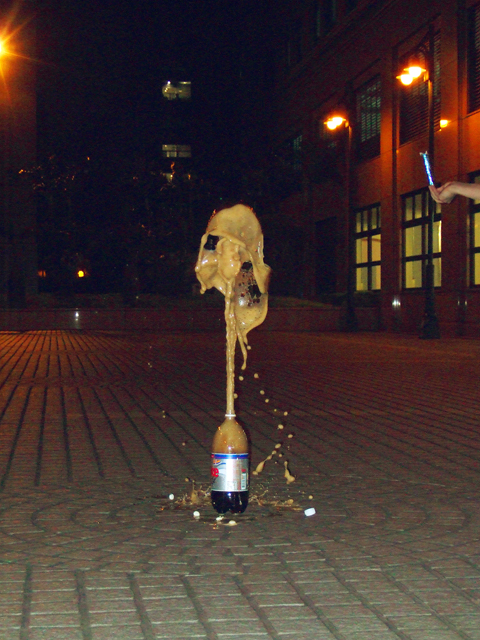This week’s experiment is lots of fun. You should do it outside in a clear area. On some grass is probably best. Make sure that there are no people or animals nearby, as it’s very messy!
What you will need:
Two two-liter bottles of diet soda

PHOTO: CATHERINE THOMAS, TAIPEI TIMES
Mint-flavored Mentos
Salt
Sunglasses, or something else to protect your eyes
■ Take the Mentos out of the package. Keep the paper wrapper intact — you’re going to use this as a tube.
■ Hold the paper wrapper tube with one hand covering the bottom hole.
■ Tip the mentos into the tube.
■ Put on your eye protection.
■ Open a bottle of diet soda and place it on a flat surface, away from anything that shouldn’t get covered in soda.
■ Crouch next to the coke bottle. Don’t stand or look over the top of the bottle. Keep just your hands near the mouth of the bottle.
■ Get ready to move well back, quickly.
■ Carefully line up the tube with the mouth of the bottle.
■ Tip the Mentos in. Move back!!!!
■ Don’t forget to record your observations in your Science Journal.
(CATHERINE THOMAS, STAFF WRITER)
本週的實驗相當有趣,你可以在空曠的戶外進行實驗,最好是在草地上,確定附近沒有路人或是動物,因為這個實驗可能會弄得很髒!所需材料︰
兩瓶兩公升裝的低卡汽水
薄荷口味的曼陀珠
鹽
太陽眼鏡,或是其他可以保護眼睛的東西
■ 把曼陀珠從包裝中取出,保持包裝紙的完整──等一下要當成管子使用。
■ 拿好包裝紙捲管,用一隻手抵住下方開口。
■ 把曼陀珠傾斜放入紙管中。
■ 戴上你的護目鏡。
■ 打開一瓶低卡汽水,然後把它放置在平坦的地面上,遠離任何不希望被汽水噴到的東西。
■ 蹲在汽水瓶旁,不要站在瓶子上方,也不要從瓶口朝下看,只有你的手可以接近瓶口。
■ 準備好往後退,動作要快。
■ 小心地將紙管對準瓶口。
■ 把曼陀珠倒進去,然後退後!!!
■ 別忘了在《科學日誌》裡記下你的觀察。
(翻譯︰袁星塵)
Further Ideas 進階點子
What happens if you use salt instead of Mentos? How about if you use regular soda instead of diet soda? Would the experiment work if you were to use baking soda instead of Mentos? Is there a difference between different brands of soda? You could use small bottles of soda to see which works best, and then use a two-liter bottle for the best one.
如果你用鹽取代曼陀珠會怎麼樣?如果你用一般汽水取代低卡汽水又會怎樣呢?如果你用小蘇打粉取代曼陀珠,汽水也會噴出來嗎?使用不同牌子的汽水,實驗結果會不同嗎?你可以先用小罐的汽水來試試看哪種牌子效果最好,然後再準備一瓶這種效果最好的兩公升裝汽水來做實驗。

A: Hard rock band Guns N’ Roses is touring Taiwan tomorrow. What about pop diva Lady Gaga? B: Unfortunately, Singapore has once again exclusively secured Gaga’s concerts in Asia, just like Taylor Swift’s exclusive Asian shows last year. A: The Singaporean government reportedly paid up to US$2.2 million to secure Swift’s shows. B: And the shows did boost its economy and tourism. A: But I’m angry about this approach, so I’m not going to Gaga’s shows this time. A: 硬式搖滾天團槍與玫瑰明天即將來台,流行天后女神卡卡呢? B: 真可惜,新加坡再度取得卡卡亞洲巡演的獨家主辦權,就像去年泰勒絲的亞洲獨家演出一樣。 A: 據報導新加坡政府付出高達220萬美元,取得泰勒絲的亞洲獨家主辦權。 B: 而她的秀也的確提振了該國的經濟和旅遊業。 A: 但我對此還是很不爽,所以不去新加坡看卡卡了! (By Eddy Chang, Taipei Times/台北時報張迪)

A: Hard rock band Guns N’ Roses and pop diva Lady Gaga are finally touring Asia again. B: Are they also coming to Taiwan? A: The band will stage a show at the Taoyuan Sunlight Arena on Saturday. B: Wow, so this will be the band’s third visit. I really love its 1992 power ballad “November Rain.” The nine-minute hit was the Billboard chart’s longest song at one point. A: Let’s go celebrate the 40th anniversary of its release. A: 硬式搖滾天團槍與玫瑰、女神卡卡終於再度展開亞洲巡演了。 B: 他們也會來台巡演嗎? A: 槍與玫瑰本週六即將在桃園陽光劇場開唱唷。 B: 哇這將是該團第三次來台演出,我超愛他們1992年強力情歌《November Rain》,全長近9分鐘還曾是告示牌排行榜最長神曲。 A: 那我們一起去慶祝該團出道40週年吧! (By Eddy Chang, Taipei Times/台北時報張迪)

Bilingual Story is a fictionalized account. 雙語故事部分內容純屬虛構。 Emma had reviewed 41 resumes that morning. While the ATS screened out 288 unqualified, she screened for AI slop. She could spot it a mile away. She muttered AI buzzwords like curses under her breath. “Team player.” “Results-driven.” “Stakeholder alignment.” “Leveraging core competencies.” Each resume reeked of AI modeling: a cemetery of cliches, tombstones of personality. AI wasn’t just changing hiring. It was draining the humanity from it. Then she found it: a plain PDF cover letter. No template. No design flourishes. The first line read: “I once tried to automate my

Every May 1, Hawaii comes alive with Lei Day, a festival celebrating the rich culture and spirit of the islands. Initiated in 1927 by the poet Don Blanding, Lei Day began as a tribute to the Hawaiian custom of making and wearing leis. The idea was quickly adopted and officially recognized as a holiday in 1929, and leis have since become a symbol of local pride and cultural preservation. In Hawaiian culture, leis are more than decorative garlands made from flowers, shells or feathers. For Hawaiians, giving a lei is as natural as saying “aloha.” It shows love and